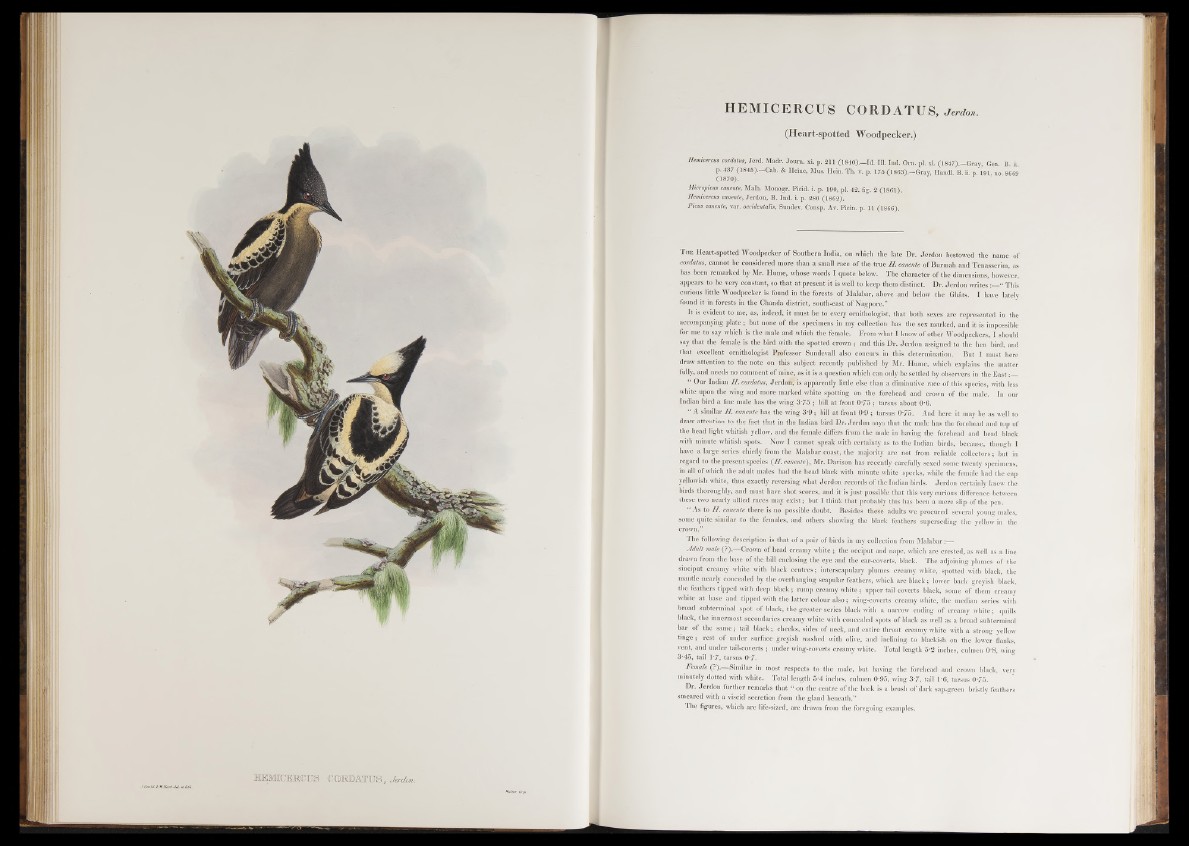
HEMICEKCHJS CORDATOS, Jerdm .
HEMICERCUS CORDATUS, j ä
(Heart-spotted Woodpecker.)
Hemkcrcus cordatos, Jerd. Madr. Journ. ri. p. 211 (1840).—Id. 111. Ind. Orn. pl. xl. (1847).—Gray, Gen. B. ii.
p. 437<fÉ846).—Cab. & Heine, Mus. Hein. Th. y, p. 175 (1863).—Gray, Handl. B.ii: p. 191, no. 8669
g l870)
Micropicus canente, Malh. Monogr. Picid. i. p. 190, pl. 42. fig. 2 (1861).
Hemicercus canente, Jerdon, B. Ind. i. p. 280 (1862).
Picus canente, var. occidentalis, Sundev. Consp. Av. Picin. p. 11 (1866).
T he Heart-spotted Woodpecker of Southern India, on which the late Dr. Jerdon bestowed the hame of
cordatus, cannot be considered more than a small race o f the true H . canente of Burmah and Tenasserim, as
has been remarked by Mr. Hume, whose words I quote below. The character o f the dimensions, however,
appears to be very constant, so that at present it is well to keep them distinct. Dr. Jerdon writes U “ This
curious little Woodpecker is found in the forests of Malabar, above and below the Ghats. I have lately
found it in forests in the Chanda district, south-east o f Nagpore.” _
It is evident to me, as, indeed, it must be to every ornithologist, that both sexes are represented in the
accompanying plate ; but none of the specimens in my collection has the sex marked, and it is impossible
for me to say which is the male and which the female. From what I know of other Woodpeckers, I should
say that the female is the bird with the spotted crown ; and this Dr. Jerdon assigned to the hen bird, and
that excellent ornithologist Professor Sundevall also concurs in this determination. But I must here
draw attention to the note on this subject recently published by Mr. Hume, which explains the matter
fully, and needs no comment o f mine, as it is a question which can only be settled by observers in the East :■__
“ Our Indian H. cordatus, JerdoiSy is apparently little else than a diminutive race o f this species, with less
white upon the wing and more marked white spotting on the forehead and crown o f the male. In our
Indian bird a fine male has the wing 3 7 5 ; bill at front 0 7 5 ; tarsus about 0 6 .
“ A similar H. canente has the wing 3-9; bill at front 0-9 ; tarsus 0 7 5 . And here it may be as well to
draw attention to the fact that in the Indian bird Dr. Jerdon says that the male has the forehead and top of
the head light whitish yellow, and the female differs from the male in having the forehead and head black
with minute whitish spots. Now I cannot speak with certainty as to the Indian birds, because, though I
have a large series chiefly from the Malabar coast, the majority are not from reliable collectors; but in
regard to the present species (H . canente), Mr. Davison has recently carefully sexed some twenty specimens,
in all of which the adult males had the head black with minute white specks, while the female had the cap
yellowish white, thus exactly reversing what Jerdon records o f the Indian birds. Jerdon certainly knew the
birds thoroughly, and must have shot scores, and it is just possible that this very curious difference between
these two nearly allied races may exist; but I think that probably this has been a mere slip of the pen.
As to H. canente there is no possible doubt. Besides these adults we procured several young males,
some quite similar to the females, and others showing the black feathers superseding the yellow in the
crown.”
The following description is that of a pair o f birds in my collection from Ma l a b a r -
Adult male (?).—Crown o f head creamy white; the occiput and nape, which are crested, as well as a line
drawn from the base of the bill enclosing the eye and the ear-coverts, black. The adjoining plumes of the
sinciput creamy white with black centres; interscapulary plumes creamy white, spotted with black, the
mantle nearly concealed by the overhanging scapular feathers, which are black; lower back greyish black,
the feathers tipped with deep black; rump creamy white; upper tail coverts black, some of them creamy
white at base and tipped with the latter colour also; wing-coverts creamy white, the median series with
broad subterminal spot of black, the greater series black with a narrow ending o f creamy white; quills
black, the innermost secondaries creamy white with concealed spots o f black as well as a broad subterminal
bar o f the same; tail black; cheeks, sides of neck, and entire throat creamy white with a strong yellow
tinge; rest of under surface greyish washed with olive, and inclining to blackish on the lower flanks,
vent, and under tail-coverts ; under wing-coverts creamy white. Total length 5-2 inches, culmen 0-8, wing
3*45, tail 1 7 , tarsus 0 7 .
Female (?). Similar in most respects to the male, but having the forehead and crown black, very
minutely dotted with white. Total length 5 -4 inches, culmen 0'95, wing 3 7 , tail 1*6, tarsus 0 7 5 .
Dr. Jerdon further remarks that “ on the centre of the back is a brush of dark sap-green bristly feathers
smeared with a viscid secretion from the gland beneath.”
The figures, which are life-sized, are drawn from the foregoing examples.